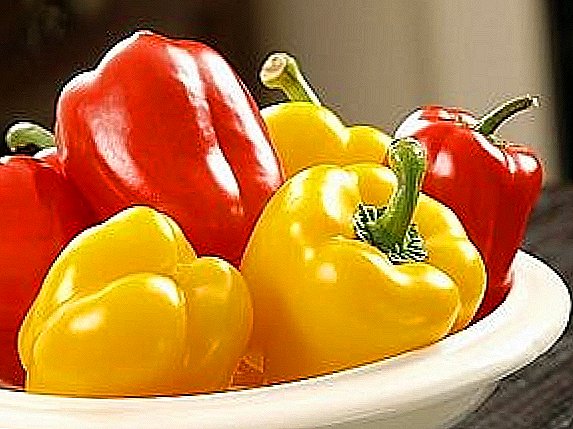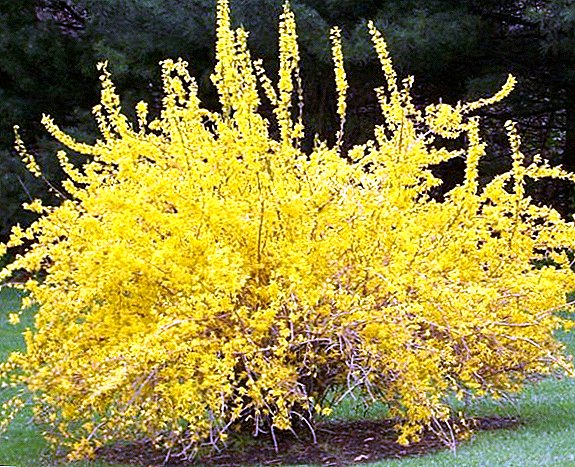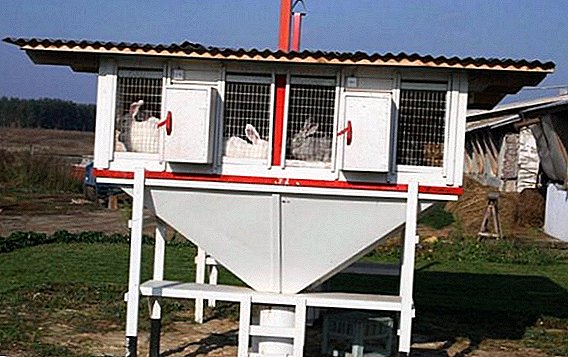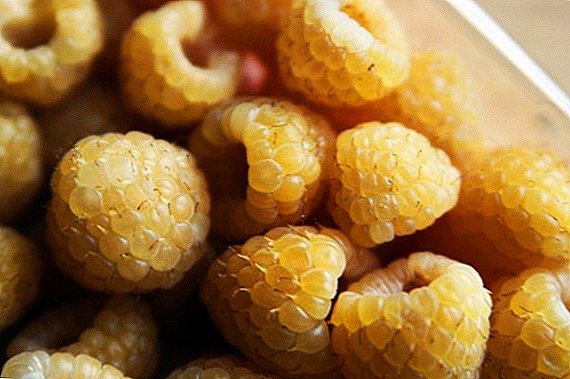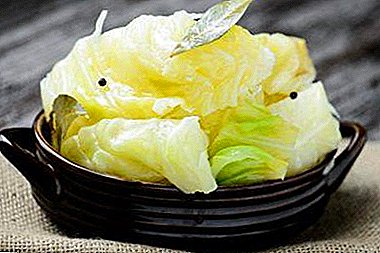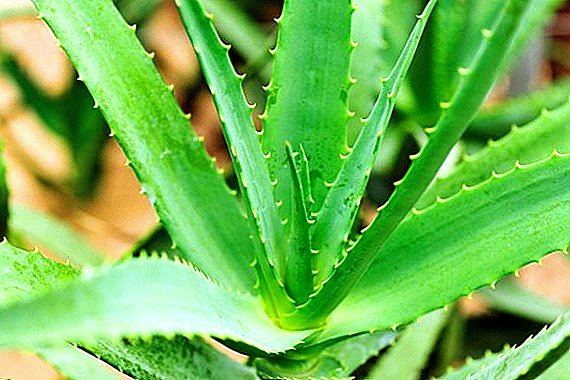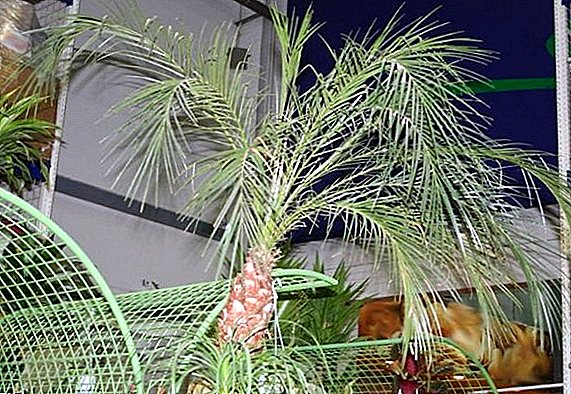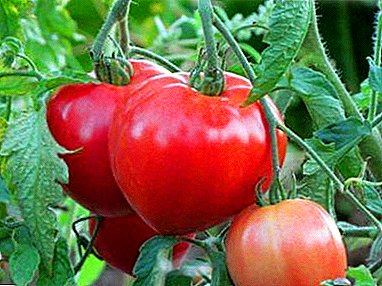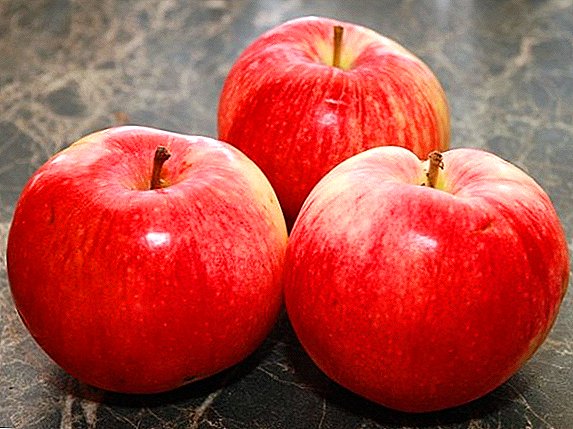 Apple Tree Delight attracts gardeners with a variety description. Its fruits attract large sizes, mouth-watering red sides and rich aroma. Their pleasant sweet taste with raspberry notes and light sourness is of interest. Even more like early maturity of apple trees, their resistance to disease and frost. Let's try to understand the pros and cons of this relatively new dessert variety, as well as analyze the characteristics of the tree in the care.
Apple Tree Delight attracts gardeners with a variety description. Its fruits attract large sizes, mouth-watering red sides and rich aroma. Their pleasant sweet taste with raspberry notes and light sourness is of interest. Even more like early maturity of apple trees, their resistance to disease and frost. Let's try to understand the pros and cons of this relatively new dessert variety, as well as analyze the characteristics of the tree in the care.
Did you know? In the composition of apples varieties Uslada are available: sugar - up to 12.8%; titrated acidity - 0.68%; tannins - 70 mg / 100 g; ascorbic acid - 25.1 mg / 100 g; P-active substances - 0.15 mg / 100 g; pectins - 10.3%.
The history of creating varieties of apple Delight
 More than fifty years ago, a well-known Russian breeder, a follower of Michurin, S. I. Isaev, developed a new early autumn variety. The result was obtained in the botanical garden of the Moscow University named after Lomonosov by complex re-crossing of wild and cultivated species of apple trees. In the experiment, among other things, the cuttings of the Narodnoe, Severyanka, and Taiga breeds were used. For 35 years, the variety has been studied, experimented. Soon, Ulad was able to adapt to growing in other regions of the country, instilling resistance to frost and increased moisture in her. Zoned apple trees have successfully spread even to rainy, damp regions of Russia and beyond.
More than fifty years ago, a well-known Russian breeder, a follower of Michurin, S. I. Isaev, developed a new early autumn variety. The result was obtained in the botanical garden of the Moscow University named after Lomonosov by complex re-crossing of wild and cultivated species of apple trees. In the experiment, among other things, the cuttings of the Narodnoe, Severyanka, and Taiga breeds were used. For 35 years, the variety has been studied, experimented. Soon, Ulad was able to adapt to growing in other regions of the country, instilling resistance to frost and increased moisture in her. Zoned apple trees have successfully spread even to rainy, damp regions of Russia and beyond.
Characteristic varieties Uslada
Feature of apple trees Delight - in unpretentiousness to growing conditions, cold resistance, resistance to diseases and high taste of fruits.
Tree description
 The apple tree of Uslada, on average, stretches no higher than 3 meters and is considered semi-dwarf. The krone is growing, prone to thickening, which prevents it from fully developing. In a young tree, it acquires a roundish shape, while in a more mature one it turns into an oval. An ingrained sapling begins to bear fruit already on the 4-5th year and brings a bountiful harvest every year - up to 80 kilograms from each apple tree. The trunk and main branches become dark gray as they grow and grow vertically with a slight slope. Young shoots rich brown, not thick, slightly covered with down. Buds are also pubescent, small, pressed to the germ. Leaves ovate, large, with a short spike at the end, fleecy from below.
The apple tree of Uslada, on average, stretches no higher than 3 meters and is considered semi-dwarf. The krone is growing, prone to thickening, which prevents it from fully developing. In a young tree, it acquires a roundish shape, while in a more mature one it turns into an oval. An ingrained sapling begins to bear fruit already on the 4-5th year and brings a bountiful harvest every year - up to 80 kilograms from each apple tree. The trunk and main branches become dark gray as they grow and grow vertically with a slight slope. Young shoots rich brown, not thick, slightly covered with down. Buds are also pubescent, small, pressed to the germ. Leaves ovate, large, with a short spike at the end, fleecy from below.
Important! If every year you do not cut the branches, the apple tree will thicken, it will bring a small crop of different sizes, and soon it will stop producing fruit at all.
Fruit Description
Apple trees bring a regular and abundant harvest. If the tree grows on nutrient-rich, well loosened soil, the maximum weight of one apple Delights can reach 200 g. On poor soils, it ranges from 100-140 g.
Fruits are round or slightly oblong, not ribbed, they smell deliciously like raspberries, when ripe they acquire a bright red or pink shade, which sometimes incorporates yellow-green fragments. The skin is elastic, thin with clear numerous white dots. The flesh is juicy, pleasant to the taste, mostly white, although it may be pale pink. Apples of this variety are good fresh and in all kinds of homemade preparations. Even in canned fruits, healthy vitamins, pectins and natural sugars are preserved.  From the middle of summer to the beginning of autumn, the period of ripening of the fruits of the apple tree Delight lasts. It is recommended to collect them immature, carefully removing from the tree. In such a case, they will successfully remain until January. For better preservation, the fruit is placed in wooden boxes and sent to the cellar. Some hostesses wipe each apple with a napkin moistened with alcohol to prevent rotting, especially carefully treating the area near the tail.
From the middle of summer to the beginning of autumn, the period of ripening of the fruits of the apple tree Delight lasts. It is recommended to collect them immature, carefully removing from the tree. In such a case, they will successfully remain until January. For better preservation, the fruit is placed in wooden boxes and sent to the cellar. Some hostesses wipe each apple with a napkin moistened with alcohol to prevent rotting, especially carefully treating the area near the tail.
By the way, overripe fruits are not showered from the branches. It is better to recycle or eat them raw. In extreme cases, they lie down for no more than a month.
Advantages and disadvantages of the apple variety “Uslada”
After analyzing all the characteristics of the variety, its description and reviews of experienced gardeners, we can conclude about the predominance of the positive qualities of Delights.
Advantages can be considered:
- adaptability of the variety to our latitudes and climatic conditions;
- endurance to cold and low temperatures, even young apple varieties of Uslada will not suffer in severe winter;
- resistance to scab and other diseases;
- fruit taste;
- early fruiting;
- regular and abundant yields;
- good preservation of apples in the winter;
- great for cultivation with a commercial purpose - the apples are large in size on the market, they look very appetizing and smell delicious;
- unpretentiousness of the tree in planting and care.
Did you know? Apples Vitamin C is two times more in apples than, for example, in Antonovka.
 Among the shortcomings of the variety - the need for regular competent pruning of the crown. It is impossible to neglect this requirement, otherwise the branches will grow strongly, releasing new, so-called "tops", which will cause irreparable damage to the vegetative process. The thickened crown will soon appear on the quantity and quality of the crop. But it is easy to fix, especially a low tree. By cons Delights can be attributed, and self-barrenness varieties. For pollination, gardeners recommend planting other types of apple trees alongside the garden.
Among the shortcomings of the variety - the need for regular competent pruning of the crown. It is impossible to neglect this requirement, otherwise the branches will grow strongly, releasing new, so-called "tops", which will cause irreparable damage to the vegetative process. The thickened crown will soon appear on the quantity and quality of the crop. But it is easy to fix, especially a low tree. By cons Delights can be attributed, and self-barrenness varieties. For pollination, gardeners recommend planting other types of apple trees alongside the garden.
Pollination of apple varieties Uslada
For cross-pollination, we recommend the neighborhood Delights and apple trees of winter varieties, as well as Papy.
Good as pollinators have proven themselves:
- The president;
- Orlik;
- Bogatyr;
- Pear;
- Welsey;
- Cowberry;
- Bolotovskoe.
For full growth, the distance between the trees in the garden should be within 4-5 meters.
Tips for planting apple tree seedlings
If the tree is provided with good conditions for the growing season, it will thank the harvest, which is enough not only for your family, you can earn money on it. Apple tree Uslada practically has no peculiarities in planting and care, because it is not a capricious culture.
Landing dates and site selection
 Wherever you decide to plant Delight, it will take root on any soil. Most comfortably, the tree will feel itself on a moisture-intensive and breathable chernozem, well-lit area among other apple trees. In the shade, the fruits will lose their sugar content, and the yield will decrease. Also, the tree does not like the nearby groundwater. Make sure that they are at least 2-3 meters away. In cases of possible flooding of the site, you should land Delight on the hill and in order to avoid stagnation of water, good drainage should be foreseen.
Wherever you decide to plant Delight, it will take root on any soil. Most comfortably, the tree will feel itself on a moisture-intensive and breathable chernozem, well-lit area among other apple trees. In the shade, the fruits will lose their sugar content, and the yield will decrease. Also, the tree does not like the nearby groundwater. Make sure that they are at least 2-3 meters away. In cases of possible flooding of the site, you should land Delight on the hill and in order to avoid stagnation of water, good drainage should be foreseen.
The optimum time for planting an apple tree. Uslada is considered to be early spring, when the snow melted and the earth was warm enough. Some gardeners prefer the fall period for planting in the last decade of September and early October. In their opinion, cultivation occurs much more successfully, since a powerful root system has time to form before the start of the growing season. This contributes to rainy wet weather. In the northern regions of the country, landing was recommended to be carried out a little earlier, focusing on climatic features.
Preparatory work before landing
The soil for spring planting is prepared in autumn, and for autumn - one month before planting the seedlings. First of all, it is loosened by carefully removing the roots of perennial weeds. Then the land is fertilized by mixing 8 kg of manure, 10 kg of peat, 100 g of superphosphate and 40 g of potassium sulfate or potassium salt per square meter of garden.
If the site was under venting, in the fall it must be carefully dug so as not to destroy the tubers of the earth. Over the winter the turf will decompose. At the beginning of spring, soil is harrowed, and in May they are again dug up.  Particular attention should be paid to the acidity of the soil. The norm for apple trees is considered to be a pH of 5.5-6.5. If it is higher, you must make the extinguished lime. Other gardeners recommend using dolomite flour or meadow marl to reduce acidity.
Particular attention should be paid to the acidity of the soil. The norm for apple trees is considered to be a pH of 5.5-6.5. If it is higher, you must make the extinguished lime. Other gardeners recommend using dolomite flour or meadow marl to reduce acidity.
Important! Lime is not mixed with phosphate fertilizers, since they are practically insoluble in the course of a chemical reaction. Lime is also not used at the same time as manure due to large nitrogen losses.
It is worth proceeding to the cultivation of a new plot two years before the laying of the garden. A few weeks before planting apple seedlings, Uslada takes on the preparation of the holes. They are dug in depth by 70-90 cm and breadth by 50-70 cm. At the same time, it is important to lay the soil from the top layer in one direction, and from the bottom - less fertile - in the other.
These requirements should not be neglected, since during the planting we will sprinkle the tree with enriched soil, i.e. removed from the upper layer. Then the bottom of the pit is thoroughly flooded and a pre-prepared filling mixture is poured with a mound, which is recommended not to be prepared in the well, but near it, which will allow to mix the fertilizer with the fertile soil from the top layer. After that, the pit is covered with a film, saving from possible rain. After 14 days, the earth will erode, and you can bury the seedling. When planting, it is important to carefully straighten its roots and water them abundantly. Before the roots should be treated clay mash.
We managed to collect the best practical tips gardeners on the preparation of nutrient mixtures for planting apple trees:
- add 10 kg of humus (can be replaced by compost), 20 g of superphosphate, 15 g of potash fertilizers;
- one planting well requires 2 buckets of humus or compost, 3 buckets of peat crumb, 1 kg of granulated superphosphate and wood ash;
- if there are no mineral fertilizers, they may well be replaced by organic ones - humus and compost;
- it is categorically not recommended to use fresh manure as fertilizer: by releasing ammonia and hydrogen sulfide, it poisons the seedling root system;
- lime and nitrogen-containing fertilizers are never added to the filling mixture because they impair the rooting of the plant;
- wood ash can be replaced with potassium sulfate (about 150 g is needed per well), in the absence of both components, 100 g of potassium chloride are added to the mixture;
- on sandy soils, approximately 10 cm of a mixture of humus and loamy soil is added to the bottom of the well for retaining moisture. And also requires potassium magnesia.
Important! When planting a seedling, the root neck should rise 5-7 cm above the ground.
Seedling planting scheme
 Despite the miniature nature of the apple trees of the Uslada variety, they are planted far from other trees, which provides them with good lighting and full development. In the schemes described in the scientific literature, a row spacing of 3-5 meters is foreseen, and the distance between apple trees in the row is 2-3 meters. A week after planting, the soil near the seedling is mulched and re-watered. Tall trees need to be tied up for the first time to pegs.
Despite the miniature nature of the apple trees of the Uslada variety, they are planted far from other trees, which provides them with good lighting and full development. In the schemes described in the scientific literature, a row spacing of 3-5 meters is foreseen, and the distance between apple trees in the row is 2-3 meters. A week after planting, the soil near the seedling is mulched and re-watered. Tall trees need to be tied up for the first time to pegs.
Apple Care Tips
For the full development of the described variety, timely cutting of branches and dressing, soil loosening and systematic watering are necessary. The most troublesome is pruning apple delight. The remaining requirements, as in other low-growing species.
Watering, loosening and weeding the soil
4-5 times a month. Delight needs watering. Under one adult tree, you need to pour a bucket of water twice a day. Watering is best done in the morning and evening. The crucial moment comes from the middle to the end of summer, during the fruiting period. At the same time, the buds of the future harvest are formed. Therefore, in order not to lose it, you need to seriously consider the water requirements of the plant.  In August, watering of the tree is stopped, otherwise the shoots will enter a long growth, which can be reflected in the winter in severe frosts. If the summer was hot, watering continued until the cold weather, so that the apple tree stretched out moisture. Periodically do not forget to loosen the soil and remove weeds.
In August, watering of the tree is stopped, otherwise the shoots will enter a long growth, which can be reflected in the winter in severe frosts. If the summer was hot, watering continued until the cold weather, so that the apple tree stretched out moisture. Periodically do not forget to loosen the soil and remove weeds.
Fertilization
Top dressing of an apple tree begins in spring, during active flowering. Gardeners widely use mineral and organic fertilizers. Often, from 5 to 15 kg of humus or horse humus (can be replaced with bird droppings or compost) is applied per square meter of tree trunks. Also prepare a mixture of 500 g of urea and 40 g of ammonium nitrate, nitroammofoski. Liquid is poured into specially prepared holes in the soil, up to 30 cm deep, which are leveled after watering.
Every autumn, when the fruits are already harvested, the tree is fed with fertilizers that do not contain nitrogen. Especially often poor, sandy lands need this procedure.
Did you know? Apple life - from 20 to 50 years.
Preventive treatment for pests and diseases
 Breeders have taken care of the stability of the apple Delight to disease. But prevention does not hurt. To this end, annually in the fall removed from the garden of fallen leaves, so that bacteria do not breed and rodents do not hide. In early spring, before bud break, the tree is treated with Bordeaux mixture: 250 g of unsold lime are diluted in 10 liters of cold water, and 250 g of copper sulfate is dissolved in 2.5 liters of warm water. Straining the first solution, it is combined with the second and carefully mixed.
Breeders have taken care of the stability of the apple Delight to disease. But prevention does not hurt. To this end, annually in the fall removed from the garden of fallen leaves, so that bacteria do not breed and rodents do not hide. In early spring, before bud break, the tree is treated with Bordeaux mixture: 250 g of unsold lime are diluted in 10 liters of cold water, and 250 g of copper sulfate is dissolved in 2.5 liters of warm water. Straining the first solution, it is combined with the second and carefully mixed.
In the period of bud break, apple trunks and branches, as well as pristolovoe soil are sprayed with insecticides. The drugs Voliam Targo, Insegar, Nurell D have recommended themselves well.
Pruning
In early spring, when the sap flow begins, the branches must be cut. The main task of such trimming is to remove the "top" and thinning the crown. In the process of work, it is necessary to ensure that the branches do not obscure each other. In mature trees, cleaning the crown contributes to their rejuvenation. By the way, shortening the branches, you can also adjust the yield, sugar content and the size of the fruit, the number of pests on the plant.
There are clear rules for competent pruning of apple trees:
- Cut by a third branch of the sapling when planting accelerate the laying of the crown.
- Systematic pruning should be done every year in March-April, before the buds bloom. Autumn pruning is not recommended.
- Inventory must be sharp.
- If it is necessary to remove the entire branch, the cut must pass at the base, without stumps.
- Place cut cut with garden pitch.
- Strongly drooping branches, hung with fruits, in cases where they lie on the ground, clean.
- When pruning young shoots, preference is given to powerful and growing straight. It is important not to confuse with the "top".
- "Tops" are removed without any regrets.
- Cut no more than ¼ shoots so as not to injure the tree.
Important! In order for the young tree to settle down better, in the first year after planting up to 80-100% of flowers are cut off on it. And in the future, get rid of half of the "zelenushek".
Protecting apple from hares
 Resistant to fierce winter tree can not resist rodents. To help the apple trees, their trunks at the bottom are tied with coniferous branches, wrapped in roofing felt, film or mesh, smeared with deterring mixtures. For their preparation using fish oil, naphthalene, lard. These fragrant means scare away even very hungry hares. Other gardeners practice black cardboard circles attached to the branches, which make a noise in the wind and do not allow nibbling the bark as protection.
Resistant to fierce winter tree can not resist rodents. To help the apple trees, their trunks at the bottom are tied with coniferous branches, wrapped in roofing felt, film or mesh, smeared with deterring mixtures. For their preparation using fish oil, naphthalene, lard. These fragrant means scare away even very hungry hares. Other gardeners practice black cardboard circles attached to the branches, which make a noise in the wind and do not allow nibbling the bark as protection.


